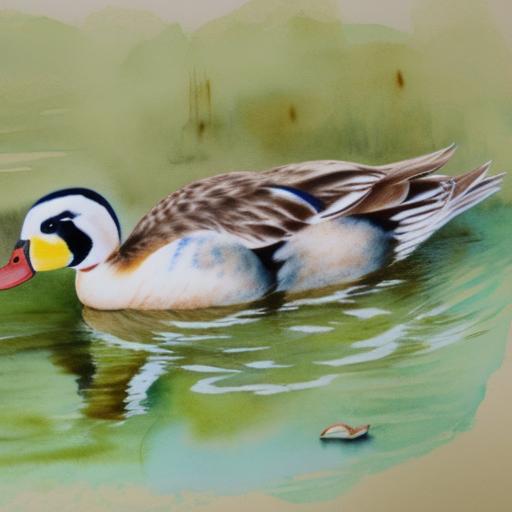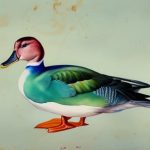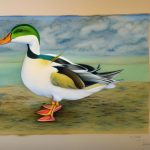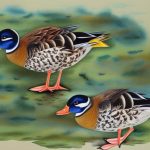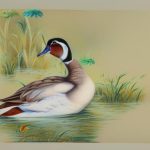The Ancona duck is a breed of domestic duck that originated in the United Kingdom. It is known for its distinctive black and white mottled plumage, which gives it a striking appearance. Anconas are medium-sized ducks with a calm and friendly disposition, making them an excellent choice for backyard breeders and small-scale farmers. They are also known for their excellent foraging abilities and adaptability to various climates, making them a popular choice for free-range duck farming.
Anconas are prolific layers, capable of producing around 210-280 eggs per year. Their eggs are large and have a creamy white shell, making them a popular choice for egg production. In addition to their egg-laying abilities, Ancona ducks are also valued for their flavorful and lean meat, making them a versatile breed for both egg and meat production. With their striking appearance, friendly demeanor, and dual-purpose capabilities, Ancona ducks have gained popularity among small-scale farmers and homesteaders looking to raise ducks for eggs and meat.
Key Takeaways
- Ancona ducks are a popular breed known for their unique black and white spotted plumage and friendly disposition.
- When selecting breeding stock, look for ducks with good conformation, strong legs, and healthy plumage to ensure the best genetic traits are passed on to offspring.
- Breeding methods and techniques for Ancona ducks include natural mating, artificial insemination, and controlled mating to achieve desired genetic traits.
- Proper housing and care for breeding ducks involves providing adequate space, access to clean water, and a balanced diet to ensure optimal health and reproduction.
- Incubation and hatching of Ancona duck eggs require a stable temperature, humidity, and regular turning of the eggs to ensure successful hatching. Caring for ducklings involves providing warmth, proper nutrition, and protection from predators. Health and disease management in Ancona duck breeding involves regular monitoring for signs of illness, providing vaccinations, and practicing good biosecurity measures to prevent the spread of disease.
Selecting Breeding Stock
When selecting breeding stock for Ancona ducks, it is important to choose birds that exhibit the desired traits for egg production, meat quality, and overall health. Look for ducks with vibrant black and white mottled plumage, as this is a defining characteristic of the breed. Additionally, select ducks that are of good size and conformation, with strong legs and a healthy appearance. It is also important to choose breeding stock that comes from reputable breeders or hatcheries to ensure genetic diversity and overall quality.
When selecting breeding stock, it is also important to consider the temperament of the ducks. Choose birds that are calm, friendly, and easy to handle, as this will make breeding and care much easier. Additionally, consider the egg-laying abilities of the ducks’ parents and grandparents to ensure that you are selecting birds with a strong genetic predisposition for prolific egg production. By carefully selecting breeding stock with the desired traits and characteristics, you can establish a strong foundation for a successful Ancona duck breeding program.
Breeding Methods and Techniques
Breeding Ancona ducks can be achieved through natural mating or artificial insemination. Natural mating involves allowing the drakes and ducks to mate freely, while artificial insemination involves manually collecting and inseminating the ducks’ eggs. Both methods have their advantages and disadvantages, and the choice of breeding method will depend on the specific goals and resources of the breeder.
For natural mating, it is important to provide a suitable environment for the ducks to mate, including access to water for mating and swimming. It is also important to ensure that there is a proper ratio of drakes to ducks to prevent over-mating and potential injury to the ducks. Additionally, observe the mating behavior of the ducks to ensure successful breeding and fertilization.
Artificial insemination can be a useful method for breeders looking to control breeding outcomes and ensure genetic diversity. This method involves collecting semen from drakes and inseminating the ducks’ eggs using specialized equipment. While artificial insemination requires more technical skill and equipment, it can be a valuable tool for breeders looking to improve specific traits or maintain genetic diversity within their breeding program.
Housing and Care for Breeding Ducks
Proper housing and care are essential for maintaining the health and well-being of breeding Ancona ducks. Provide a spacious and secure housing environment that protects the ducks from predators and the elements while allowing for ample space to move and exercise. The housing should also include nesting boxes or areas for the ducks to lay their eggs in a comfortable and safe environment.
In addition to housing, provide a balanced diet that meets the nutritional needs of breeding ducks. A diet rich in protein, vitamins, and minerals will support egg production and overall health. Ensure access to clean water at all times, as ducks require water for drinking, bathing, and mating.
Regular health checks are also important for breeding ducks to monitor for any signs of illness or disease. Establish a relationship with a veterinarian experienced in poultry care to provide routine check-ups and address any health concerns that may arise. By providing proper housing, nutrition, and healthcare, breeders can ensure the well-being of their breeding Ancona ducks.
Incubation and Hatching
Incubating Ancona duck eggs is an essential part of the breeding process. Whether using an incubator or natural brooding methods, it is important to provide the optimal conditions for successful egg incubation and hatching. For breeders using an incubator, carefully follow the manufacturer’s instructions for temperature, humidity, and turning of the eggs to ensure proper development.
For natural brooding methods, provide a suitable nesting area for the duck to lay her eggs and care for them until they hatch. Ensure that the nesting area is secluded and safe from predators to minimize stress on the brooding duck. Monitor the nesting duck closely during this time to ensure that she is caring for her eggs properly.
Once the eggs begin to hatch, provide a warm and safe environment for the ducklings to thrive. A brooder with a heat lamp or heating pad can provide the necessary warmth for the ducklings as they adjust to their new environment. Additionally, provide access to clean water and a balanced diet formulated specifically for young ducklings to support their growth and development.
Caring for Ducklings

Caring for Ancona ducklings requires attention to their specific needs for warmth, nutrition, and protection. Provide a warm brooding area with access to heat lamps or heating pads to maintain an optimal temperature for the ducklings. Monitor the temperature regularly to ensure that it remains within the recommended range for young ducklings.
In addition to warmth, provide a balanced diet formulated specifically for young ducklings. A starter feed with high protein content will support healthy growth and development during this critical stage. Ensure access to clean water at all times, as ducklings require water for drinking and bathing from an early age.
Protecting ducklings from predators is also essential during this vulnerable stage of development. Ensure that their brooding area is secure from potential threats and monitor their surroundings closely. By providing proper warmth, nutrition, and protection, breeders can ensure the health and well-being of their Ancona ducklings as they grow.
Health and Disease Management in Ancona Duck Breeding
Maintaining the health of breeding Ancona ducks is essential for successful breeding outcomes. Implementing biosecurity measures can help prevent the introduction and spread of diseases within the breeding flock. This includes limiting exposure to outside birds, practicing good hygiene, and monitoring for any signs of illness or disease.
Regular health checks by a qualified veterinarian experienced in poultry care can help identify any potential health issues early on. Vaccinations may also be recommended based on the specific disease risks in your region. Additionally, provide a clean and sanitary environment for the ducks, including regular cleaning of housing areas and providing access to clean water at all times.
In the event of illness or disease outbreaks, it is important to isolate affected birds and seek veterinary care promptly. Implementing quarantine measures can help prevent the spread of disease within the breeding flock while affected birds receive appropriate treatment.
By implementing proactive measures for health and disease management, breeders can maintain the overall health and well-being of their Ancona duck breeding flock while minimizing the risk of disease outbreaks. Regular monitoring, good hygiene practices, and prompt veterinary care are essential components of effective health management in Ancona duck breeding programs.
In conclusion, breeding Ancona ducks can be a rewarding endeavor for small-scale farmers and homesteaders looking to raise ducks for eggs and meat production. By carefully selecting breeding stock with desirable traits, implementing effective breeding methods and techniques, providing proper housing and care, incubating eggs successfully, caring for ducklings, and managing health and disease risks, breeders can establish a successful Ancona duck breeding program. With attention to detail and proactive management practices, breeders can enjoy the benefits of raising these striking and versatile ducks on their farm or homestead.
If you’re interested in Ancona duck breeding, you may also want to explore tips for creating the perfect environment for your poultry. Check out this informative article on how to insulate a chicken coop to ensure that your ducks and chickens stay warm and comfortable during colder months. Proper insulation is essential for maintaining a healthy and productive flock.
FAQs
What is Ancona duck breeding?
Ancona duck breeding refers to the process of raising and breeding Ancona ducks for various purposes such as egg production, meat, or as pets.
What are Ancona ducks?
Ancona ducks are a breed of domestic duck that originated in the United Kingdom. They are known for their distinctive mottled plumage and are often raised for their egg-laying abilities.
What are the characteristics of Ancona ducks?
Ancona ducks are medium-sized with a sturdy build. They have a mottled color pattern with white feathers marked with black spots. They are known for being hardy, good foragers, and excellent layers of large white eggs.
How are Ancona ducks bred?
Ancona ducks can be bred through natural mating or artificial insemination. Breeders may select specific ducks with desirable traits to produce offspring with the desired characteristics.
What are the considerations for breeding Ancona ducks?
When breeding Ancona ducks, it is important to consider the health and genetic traits of the parent ducks, as well as providing proper nutrition and housing for the breeding ducks and their offspring.
What is the breeding season for Ancona ducks?
Ancona ducks typically breed in the spring and summer months, although they may also breed at other times of the year depending on environmental conditions and breeding practices.
What are some tips for successful Ancona duck breeding?
Some tips for successful Ancona duck breeding include providing a suitable nesting area, ensuring proper nutrition and access to clean water, and monitoring the health and behavior of the breeding ducks. It is also important to provide a stress-free environment for the ducks during the breeding process.
Meet Walter, the feathered-friend fanatic of Florida! Nestled in the sunshine state, Walter struts through life with his feathered companions, clucking his way to happiness. With a coop that’s fancier than a five-star hotel, he’s the Don Juan of the chicken world. When he’s not teaching his hens to do the cha-cha, you’ll find him in a heated debate with his prized rooster, Sir Clucks-a-Lot. Walter’s poultry passion is no yolk; he’s the sunny-side-up guy you never knew you needed in your flock of friends!

